Genre: Shmup Developer: Telnet Publisher: Renovation Players: 1 Released: 1990
Back around 1990 when the Genesis was first trying to get established in the market, we began to see a swarm of shooters from a few companies all striving for a buck. Renovation was one of those companies, usually translating those mediocre to okay titles from the Mega Drive to the states. Of those titles brought to us was Arrow Flash and I must say that this is one of the better titles Renovation Products ported over.
In the latter half of the 30th century, a frightening rumor reached the planet Earth. A group of Viking terrorists, led by a vicious tyrant known as the Great Hilagi, has been plundering and destroying planets throughout the Galaxy. They moved in ominous war ships capable of entering and traveling in Nether Space. Yet the people of planet Earth never suspected that of all the planets in the Galaxy, Earth was to be Hilagi’s next target.
Zana Keene, who had trained as a test pilot at the United Government Military Academy, was the only one with .access to the space fighter “Chameleon”; the battle weapon ERX-75, a space fighter capable of combat in Nether Space; capable of transforming itself into a robot; the strongest weapon ever developed by the United Earth Army – code name, Valdor. Chameleon was the only existing prototype. Its production plant has been sabotaged and destroyed. Zana Keene knew what she must do. “Use this… save Earth.”
Arrow Flash uses an engine reminiscent of some of the standard and basic shooters of the time. It’s a run-of-the-mill side scroller that has five levels. Usually the levels are divided into sub-stages of two or three and a player knows when one has ended by the background and music fading to black and then being replaced by new ones. Whippee. There are some bosses but they sometimes come in between sub-stages or at the end of the level. The bosses are few and extremely easy to defeat. That goes for the standard attacking enemies that come in basic patterns and are easily shot down. More whippee.
The ship is unique in the respect that it does change into a robot, and with the change to robotic form, the options that usually follow the ship will assume a formation to the upper and lower left of the robot. As far as weapons go, there are only 3 different weapons to get, nicely named I, II, and III. The first is an upgraded blue shot that is longer in length while the second is a yellow firing laser with a little more power but less fire rate, and the third is a poor-looking wavey laser that will do massive damage but the fire rate is the slowest of the three. The main shot of the ship can be increased to be more damaging by acquiring more power-ups and the power rate will be kept when picking up another weapon. Additional firepower is provided by the typical missiles that come in packages of two (another whoop) and, amazingly enough, actually have homing capabilities, thus making the game that much easier too. Oh yeah, I almost forgot, the missiles can be upgraded once to fire four and they will be much faster.
And what shooter would be so without a shield that can take a couple of hits, that is of course, given that you actually get hit. There are also speed power-ups that increase maneuverability with each one. The only thing that makes the game a little different than the others is the use of the super weapon. The Arrow Flash will engulf the entire robot within a big white flaming light that allows for the robot to go plow through anything that may come in its path. The Arrow Flash changes to the V-Attack for ship mode which fires a brief albeit harsh seven layered spear attack that wipes out just about anything in the path of the ship. Although the super weapon has a limited use, you can pick up additional units of power for it along the way.
One upper is the graphics. Although not graphic intensive all around, there are parts to where a boss is particularly detailed here or a background is nice there. Probably the most notable and memorable is the background from the third stage that produces a smooth wavey background which showed (back in 1990 mind you) what the Genesis processor was capable of handling. Parallax scrolling is seen but is sometimes weak… if there is any at all. The cloud and space levels are multi-layered and they look good in showing speed, but a couple of the latter levels are done poorly. Some look like a couple of blocks stacked upon each other, with only one moving slightly faster than the next (that was sort of ugly). The game did have a nice small intro sequence with a cool anime pic of the pilot and some pics of the ship. All in all though, the graphics are good, even if they are sometimes sparse.
Another plus to Arrow Flash is all the music themes for the levels. Almost all the music had very good themes to them and were even worth listening to again in the option’s sound test menu. The sound effects used for the game though are kind of weak. They’re not very intense, usually short, and pretty basic sounding. Even the explosions and shotdowns of enemies are lame, but at least it’s not annoying to the ears, so that’s a plus too. I guess you could say that the sounds are fair at best. They suit the game, but the sound could have been a little better in places.
If you’re looking for an extremely hard game to master, you’re looking at the wrong title. Even though it’s fun enough to play, Arrow Flash is one of those that you’ll probably beat in a day. Seriously speaking, even if you don’t continue, it’s not extremely long or hard so you should lick this without much of a fight, even if you’re not a veteran gamer. It’s only mildly difficult at the most. There are some nice options to toggle in the options menu though. The difficulty can be changed from easy, normal, or hard and veterans are immediately advised to put the level up to hard. If you do, enemies will take a couple more hits to kill and they will fire more bullets, plus it won’t let you continue. As if the game wasn’t easy enough, the ship stock can be changed from the default of three to five or even seven (sheesh.)
The next feature which is nice is the sound test that will allow you to listen to all the music from the game (bonus). Control pad configuration can be altered to six different settings to the likings of any player. There is also a rapid fire toggle that will turn it from off to on, so in case you REALLY suck, this will help you out (if this is the case, I hope I never meet you.) Finally, probably the most notable option available is the ability to change the Arrow Flash weapon from stock to charge. Instead of having to collect the power-up AF units to continue using the mega weapon, it will instead be presented as a charge meter. Once the Arrow Flash (or V-Attack) is used, the player must then wait for it to recharge again before the next use. So, as you can see, there are some good options available for the most part.
Arrow Flash is an above average title. While the graphics and music are good, the sound and challenge are not as good as they should be. It does provide some good old fashion fun and if you can find it cheap, I’d say pick it up. It’s definitely not worth the original $70 price tag that Renovation loved selling their games at, but for a reasonable price it’s decent. The game presents a scenic hayride at its best and could basically be considered for play so you can get another notch on your control pad when you complete it. Not a bad game, but not a great game.
SCORE: 6 out of 10
Originally printed at Starbase299.

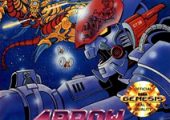
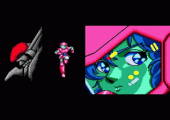
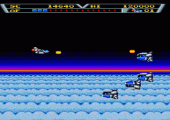
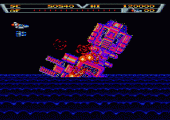
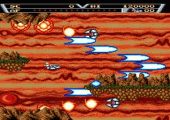
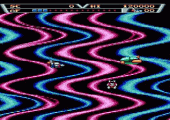
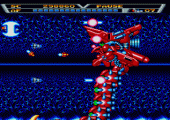
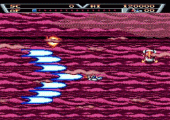
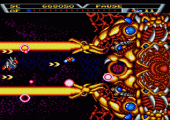
Set arrow flash set to charge, difficulty hard. Much more of a challenge.
That requires more memorization since arrow flashes can’t be instantly used with just a tap of the button.
There’s also usually not enough time to charge more than one arrow flash during boss fights when it’s set to charge. Some of those boss patterns aren’t just an easy defeat when fighting them without using arrow flashes.